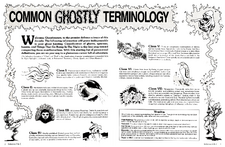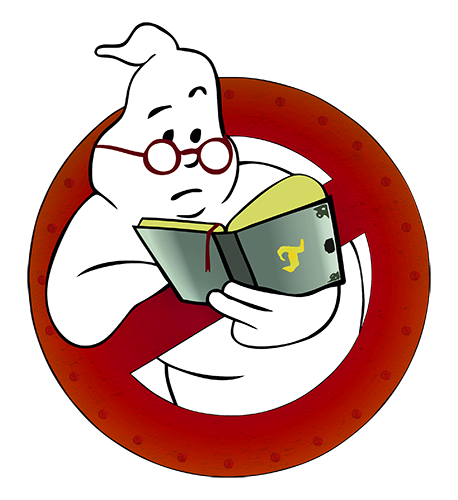The CDI System is a way to set categories to types of supernatural phenomenon. It is a three part system used by the Ghostbusters when addressing the paranormal they are coming in contact with.
The CDI System was first brought up in the Ghostbusters film by Ray Stantz after busting the ghost haunting the Sedgewick Hotel when he proudly showing off the Trap said:
"Sir, what you had there was what we refer to as a Focused, Non-Terminal, Repeating Phantasm, or a Class 5 Full-Roaming Vapor . . . a real nasty one too"

As seen in Ghostbusters Role-Playing Game (Click here to look at the full size of the file)
Classification System
A clear list system was made in Ghostbuster RPG, which is the standard most fans go by. The class system is known mostly as list of seven classes that a paranormal event can be labeled to better understand and deal with.
These are undeveloped forms, insubstantial and difficult to see. Interaction with their environment is limited and enigmatic (i.e., spectral lights, voices and sounds, ectoplasmic vapors, etc.). Simple application of a proton pack beam is normally effective.
Manifestations focused in this time and space, Class II ghosts and up can physically manipulate things in this world. These forms are vague, inconsistent, or incomplete (i.e., floating sheets, ghostly hands, animated lips, etc.). Although a proton pack beam is normally effective, some Class II ghosts have the capacity to return attacks.
Anonymous Hauntings. Distinct human form and personality is evident, but former identity (I.E., as a living being.) is not established. If established, ghost is reassigned as Class IV. Often difficult to deal with, Class III ghosts generally possess sophisticated means of defense.
Identity is established. They have a distinct human form and personality with known identity, such as General Custer or Cleopatra. Economic disposal methods include research into the background of said entity, as well as possible communication with it.
These are Ectoplasmic manifestations of definite but non-human form. Speculation includes the theory that Class V's are formed from emotionally-charged events or as side effects from ritual summoning (Slimer was a by-product of the rituals that a cult held in the Sedgewick Hotel's basement.). These typically require extensive proton pack implementation to eradicate.
Ghosts from lower life forms. A giant penguin was once seen attacking a mugger in Central Park. Later it was discovered that the penguin was a ghost. Unique solutions are often required to handle these entities, including research into habitats, allergies, natural enemies, etc.
Metaspectres. Obsessively malevolent, exceptionally powerful, and exhibiting control over subordinate forms, such entities are potentially very dangerous. These are often identified by primitive cultures as "Demons". Entitles which fit this classification include Gozer and Zuul. Neutralizing them is usually a problematical undertaking at best. Most standard procedures are futile. The most realistic plan is to take measures to prevent these things from entering the sphere of influence in the first place.
Description System
- Ghosts: Spirits or souls of the deceased.
- Corporeal: Tangible manifestations.
- Deity: Supreme Beings.
- Unstable: A physical manifestation who forms itself with paranormally compromised items.
- Environmental: Ectoplasm, its Sub-Classes, and effects of.
- Vathek: Spectral forms who enter the realm of the living through the act of writing.
- Legends: Entities popularized by mythologizes, folklore, and legends.
Identification System
- Anchored: Indicates that a ghost is tied to a particular location.
- Animating or Animator: An entity capable of animating an object whether by telekinesis or by inhabiting them.
- Caustic: Corrosive, burning, or just plain dangerous.
- Composite: A collection of things.
- Corporeal: Tangible or having a physical body.
- Ethereal: Disembodied or intangible.
- Floater: An entity capable of limited flight.
- Focused: The ghost is tied to the specific locale in which it first appeared and cannot stray from it.
- Free Floating: A ghost that moves about at will, with no regard to buildings, people, or time and space, as we know it. Sometimes just called "free".
- Free-Roaming: An entity that roams freely and is not bound to any location.
- Free-Roaming Vapor: A wispy entity that simply roams around freely.
- FRVP: A free-repeating vaporous phantasm. Sometimes a grotesquely altered human form.
- Full Torso or Full-Torsoed: Some ghosts have full torsos, some have arms and legs, and some have no head and the like. Full torso apparitions are relatively rare - many hauntings are indistinct below the chest. It is an entity with no lower body.
- Inhabiting: A creature that occupies and binds to an inanimate object, like a possessor, but one that acts out of pure instinct rather than higher reasoning.
- Kinetic: Of or relating to movement.
- Paranormal: Beyond normal; Strange, unnatural, or unknown.
- Plane or Planar: Realm or dimension, or of a realm or dimension.
- Possessor: A ghost capable of possessing objects or people.
- Reactive: Responsive.
- Remnant: A spirit that remains in this world as a result of being unable to completely cross over, as opposed to those that choose to return to the mortal plane.
- Repeating or Repeater: May refer to a self-regenerating P.K.E. force (Common with ritually-summoned spooks) or to a spook with obsessive repetitious behavior patterns (i.e., Always manifesting at a certain place and time). Even when the ghost can be captured or eliminated, some agency continues to produce successive hauntings. Such ghosts reappear periodically until the source can be disabled.
- Secretion: Something sticky and oozy, mucus or slime.
- Seep: Short for seepage; see Secretion
- Swarmer: An entity that travels in packs and swarms around its prey.
- Telekinetic: Having the ability to move things without physical or ectoplasmic contact; having the ability to move things from a distance.
- Transdimensional: Outside of this dimension.
- Ultradimensional: Across of this dimension.
- Vapor, Vaporous, or Mist: A common but imprecise term, it may refer to a Class I or II entity, or any insubstantial haunting.
- Wandering Possessor: A wandering entity that can possess objects or people.
Animated Classifications
Please go here
